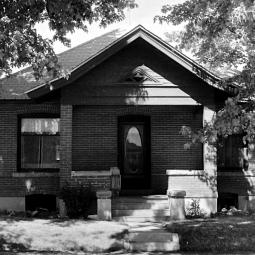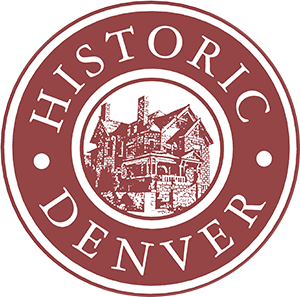The history of 1449 Quebec Street is really the history of Colfax Avenue, as viewed through the lens of a single home. 1449 & 1445 Quebec were among the first houses near Colfax and Quebec St, (formerly known as Hyde Park Avenue), out in Denver's historic Montclair neighborhood. The 1400 block of Quebec Street was originally owned by Denver's famous Baron Walter von Richthofen. Through talking with several of my elderly neighbors, I discovered that this house has been part of a local legend. Neighbors claim that the house at 1449 Quebec was originally built for one of Baron Richthofen's workers and that from time to time, some of his horses were actually kept in the carriage house on the property. I thought it would be interesting to try validate that claim, but the Baron passed away in 1898 and the house wasn't built until 1908.
Right after the former town of Montclair (founded in 1885) was annexed by Denver in 1904, restrictions put in place by Baron Walter von Richthofen, regarding the size of homes built in the community, were lifted. The restrictions were that all houses "be built at least three stories high, cost a minimum of $10,000 and that "all plans for houses be submitted for approval by the board of trustees", (Noel, 1976). This allowed for the construction of smaller, middle class homes to be built in Montclair.
Regarding the actual history of 1449 Quebec St., also known as Quebec House, I've been able to uncover that this home was built by a master brick layer, named William R. Gore. He would buy properties, construct houses on them, by himself, before selling and moving on to his next project. The carriage house at 1449 Quebec was actually constructed first, in 1906. William and his wife Lottie lived together there until the main house was completed in 1908. From the kitchen window, they would have been able to look out and see downtown Denver to the West. Of course, this would have been before all the trees we see today had been planted.
The house is constructed of solid red brick and is a great example of the early American bungalow (which would come to dominate the landscape as the middle class continued to grow). The home is unusual in the fact that it's nearly double the size of similar bungalows found closer to downtown - due largely in part to the large size of Montclair's lots. In Tom Noel's notes on the property, when he surveyed it back in the 1970s, he mentioned the well manicured yard, original carriage house, oval glass front door, as well as leaded and stained glass windows. In his words, "Brick bays along with the front porch (repeating the flared hip roof) give this house an endearing symmetry”. There is actually a great black and white photo of the front of the house, taken by Tom Noel, on file in the digital archives of the Denver Library's Western History department.
Neighbors claim that this house used to be quite the showpiece of this corner of the Montclair neighborhood. It was a true craftsman home, with lots of oak built-ins, beautiful hardwood floors, and crown molding in every room. The original red sandstone city sidewalk still remains in front of the house, as well as next door at 1445 Quebec. These two homes were actually once part of a historic walking tour of the neighborhood. This was before Montclair Historical Society decided to narrow it's focus to a larger cluster of historic homes closer to the center of the neighborhood.
I've only been able to find one other house built by Gore and it still remains just a few blocks from this house, at 16th and Poplar Street. Gore and his wife moved out to San Francisco around 1914, and soon after William joined the US Navy, during WWI. I haven't been able to find much more information about the Gores after that time.
In 1911, Gore had sold 1449 Quebec to a young family, who owned the small, brick house next door (at 1445 Quebec). They were the John and Helen Burlien family. John and Helen had moved west to Denver from New Jersey after marrying in 1900. John’s brother Henry, who had moved out to Denver a few years earlier, helped John find work as a bookkeeper for the local W.S. Cheesman Realty Company, (where he would go on to work for over 26 years). In addition to owning several commercial properties along Colfax, John also purchased and rented one of the shops at Colfax and Pearl St, (most recently home to the Cheeky Monk restaurant and bar).
John and Helen purchased land out in Montclair to get away from the hustle and bustle of downtown Denver, and to have a suitable home for their young daughter, Dorothy (born in 1901). Their small brick cottage at 1445 Quebec was constructed by the Bowen & Disnmore Company in 1907. It was in an ideal location, since Montclair was one of Denver's first streetcar suburbs and their new home was right near the Poplar Street Loop at Colfax & Poplar. Expecting their second daughter, Janette, the Burliens purchased the larger house at 1449 Quebec, (keeping their smaller home as a rental property. The Burliens would also have a third daughter in the new house, Lois, in the Fall of 1912.
The Burliens were very active at the local St. James' Catholic Parish. When John died in 1956, at the age of 86, he bequeathed $75,000 to a local seminary (to educate future priests) and $1,000 to the St. James' Parish. That same year, Helen and Lois donated the family piano to the local St. James' Catholic School.
After Helen passed away in 1959, the home was passed down to her youngest daughter, Lois. Lois and her husband, Garth "Michael" McGovern, would go on to live in the house until they passed away in the late 1980s / early 1990s. Lois and Michael McGovern never had any children, however, and the home was passed down to a nephew, Janette's son, John Burlien Friel, (named after his maternal grandfather). The house would remain in a family trust until 1996, when it was sold to someone outside the family. In total, the home had remained in the Burlien family for 85 years.
From 1996 to 2009, the home was purchased twice and lost both times in foreclosure. During that time, the home had been neglected and had fallen into severe disrepair. A fire nearly destroyed the entire property, in December of 2003, and caused over half of the rear exterior wall to collapse. It took over 30 firemen to put out the flames. Fortunately the owner and her daughter, who had been living with her, were able to escape, but many of their pets were lost.
After the fire, the entire roof had to be rebuilt. The owners at that time, also tried to reconstruct the interior of the house, but they eventually ran out of funds. After the home was foreclosed upon in 2009, the house sat empty until it was purchased later that year. A series of renovations followed, (many of which eliminated any remaining historic features of the home - including the leaded and stained glass windows and oval glass front door), but the cost of repairs was too great and the developers also lost the property to foreclosure in the Fall of 2011.
After I purchased the home in February of 2012, the house has undergone several additional interior and exterior renovations. My goal is to try and restore the home to its former glory, so it can once again join the ranks of other respectable historic Montclair homes and last another 110 years.




